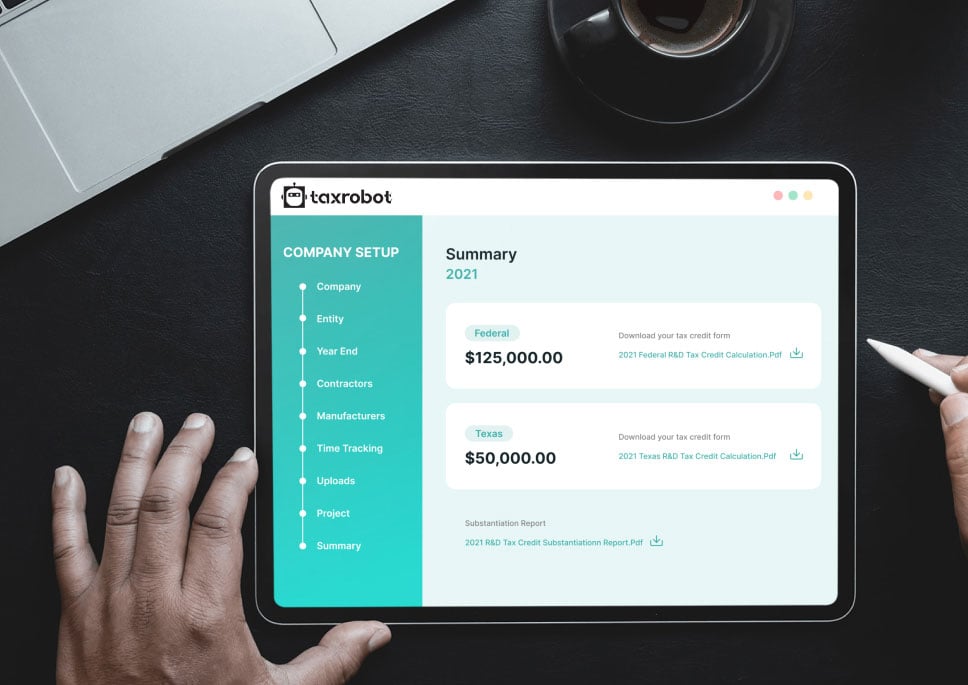Wyoming R&D Tax Credit
With Tax Robot, Wyoming R&D Tax Credit becomes more than a benefit—it becomes a catalyst for your business growth. Unleashing the incredible, simplifying the complex. This is not just tax planning; it’s financial evolution.
Maximize your State Credits today!
Put the R&D tax credit process on autopilot.
Trusted By:








Wyoming R&D Tax Credit
Discover your eligibility for Wyoming R&D tax credits and supercharge your enterprise.
Unlock the Potential of Federal R&D Tax Credits in Wyoming with TaxRobot
In Wyoming, businesses may find themselves at a crossroads regarding Research and Development (R&D) tax credits.
While Wyoming doesn’t offer state-level R&D tax credits, there’s a silver lining: the Federal R&D Tax Credit program. This underutilized financial incentive can be a game-changer for companies engaged in qualifying research activities.
TaxRobot is here to demystify this complex landscape. Our AI-powered software simplifies the process, ensuring you claim every dollar you’re entitled to.
Discover how TaxRobot can be your guiding light in maximizing Federal R&D Tax Credits in Wyoming.
Get started with TaxRobot today and unlock the full potential of your R&D investments!
Why Wyoming Businesses Should Consider Federal R&D Tax Credits
The absence of state-level R&D tax credits in Wyoming might seem like a setback. Still, it’s crucial not to overlook the substantial benefits offered by the Federal R&D Tax Credit program.
This financial incentive is designed to fuel innovation and growth across many industries. Whether in technology, healthcare, or manufacturing, these credits can significantly offset your research costs, enhancing your competitive edge.
TaxRobot’s expertise in this domain ensures that you navigate the federal program with ease, optimizing your claims for maximum returns. Don’t let state limitations hinder your growth; seize the federal opportunity with TaxRobot.
How TaxRobot Simplifies the Federal R&D Tax Credit Process
Navigating the labyrinthine regulations of Federal R&D Tax Credits can be daunting. That’s where TaxRobot steps in, transforming complexity into simplicity with our AI-powered software.
Our streamlined three-step process—Provide Information, Link Your Systems, Receive Your Refund—eliminates the guesswork.
We leverage cutting-edge algorithms to analyze your data, ensuring you claim the maximum credits you’re eligible for, all while maintaining audit-proof documentation.
With TaxRobot, you’re not just saving money but also reclaiming valuable time, allowing you to focus on what truly matters—innovation and growth.
Key Features of TaxRobot’s R&D Tax Credit Software
TaxRobot’s feature-rich R&D tax credit software stands as a beacon of efficiency and reliability in a landscape where every dollar counts. Our platform offers bigger refunds, audit-proof paperwork, and value-based pricing tailored to your unique business needs.
Our software, powered by advanced algorithms, meticulously scans your financial activities, identifying untapped opportunities for tax credits.
The result? A robust, comprehensive solution that not only maximizes your refund but also fortifies your financial documentation against audits.
Elevate your tax strategy with TaxRobot and experience the pinnacle of R&D tax credit optimization.
Get Started with a Free Estimate
Ready to unlock the full potential of Federal R&D Tax Credits? Take the first step with TaxRobot’s no-obligation, free estimate.
Our “Get a Free Estimate” button is more than just a call-to-action; it’s your gateway to financial optimization.
By leveraging our AI-driven analysis, you’ll understand the tax credits you could be claiming.
Don’t leave money on the table; seize this opportunity to maximize your R&D investments with TaxRobot today.
Why TaxRobot is Your Trusted Partner for Federal R&D Tax Credits in Wyoming
Having a reliable partner is invaluable in the intricate world of R&D tax credits. TaxRobot is that partner.
Backed by a team of R&D tax experts with a proven track record, we offer more than just software; we offer peace of mind.
Our value-based pricing and robust audit support underscore our commitment to your success. With TaxRobot, you’re not navigating the complexities of Federal R&D Tax Credits alone; you’re backed by a team of experts dedicated to maximizing your financial gains.
Choose TaxRobot and experience the epitome of efficiency, expertise, and reliability.
Take a sneak peak

- Limited Time Offer
- Simple Onboarding
- Easy to Use
R&D Tax Credits FAQs
The four-part test as outlined in the Internal Revenue Code is used to determine qualified R&D activity.
The Four-Part Test
1). New Or Improved Business Component
Creation of a new product, process, formula, invention, software, or technique; or improving the performance, functionality, quality, or reliability of existing business component.
- Construction of new buildings or renovation of existing buildings
- Invention of a software application
- Manufacturing of a new product or the improvement of the production process for an existing product
- Creation of design documentation
2). Technological In Nature
The activity fundamentally relies on principles of the physical or biological sciences, engineering, or computer science. A taxpayer does not need to obtain information that exceeds, expands or refines the common knowledge of skilled professionals in a particular field.
- Physics (relationship between mass, density and volume; loading as the
result of gravitational attraction) - Engineering (mechanical, electrical, civil, chemical)
- Computer science (theory of computation and design of computational systems)
3). Elimination Of Uncertainty
Uncertainty exists if the information available to the taxpayer does not establish the capability or method for developing or improving the business component, or the appropriate design of the business component.
- The capability of a manufacturer to create a part within the specified tolerances
- The appropriate method of overcoming unsuitable soil conditions during construction
- The appropriate software design to meet quality and volatility requirements
4). Process Of Experimentation
A process designed to evaluate one or more alternatives to achieve a result where the capability or method of achieving that result, or the appropriate design of that result, is uncertain as of the beginning of the taxpayer’s research activities.
- Systematic process of trial and error
- Evaluating alternative means and methods
- Computer modeling or simulation Prototyping Testing
The R&D tax credit is one of the most misunderstood tax incentives available. Considering the myriad of industries and activities that legally qualify for the credit, the term “research and development” is a misnomer. Additionally, the R&D tax credit requires specialized knowledge and technology to identify and calculate the incentive properly.
Companies of various industries are unaware that they are eligible to claim the R&D tax credit. Under the Internal Revenue Code’s definition of R&D, many common activities qualify. You can get tax benefits for industries including software, technology, architecture, engineering, construction, manufacturing, and more.
The R&D tax credit can be claimed for all open tax years. Generally, open tax years include the prior three tax years due to the statute of limitations period. In certain circumstances, the law allows businesses to claim the R&D tax credit for an extended period of time. It is common for companies to amend previous tax years to claim this benefit and reduce the maximum amount of tax liability.
Partnerships and S corporations must file this form to claim the credit. The credit will flow from the Form 6765, to the Schedule K-1, to the Form 3800 on the individual’s tax return. For individuals receiving this credit that have ownership interest in a partnership or S corporation, Form 6765 is not required on the individual return.
Individuals claiming this credit can report the credit directly on Form 3800, General Business Credit if their only source for the credit is a partnership, S corporation, estate, or trust. Otherwise, Form 6765 must be filed with the individual’s tax return (e.g. sole proprietorship).
For tax years prior to 2016, the credit can be used to reduce the taxpayer’s regular tax liability down to the tentative minimum tax. The credit cannot be used to offset alternative minimum tax. Beginning in tax year 2016, eligible small businesses have expanded utilization for the credit. For these eligible small businesses, the regular tax liability can offset alternative minimum tax using the “25/25” rule.
What our customers have to say
I highly recommend TaxRobot to anyone considering an R&D Tax Credit software to complete their analysis.

We decided to switch to TaxRobot… Best decision we’ve ever made. More affordable, and less complicated.

I couldn’t believe how easy it was! In under an hour, we saved enough money to hire a new employee.
